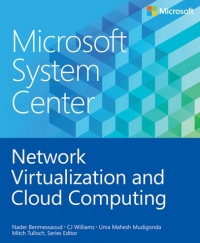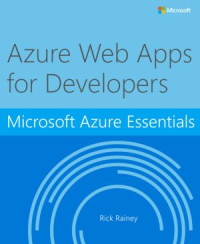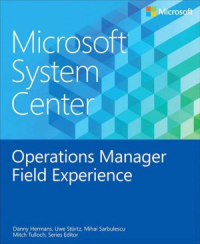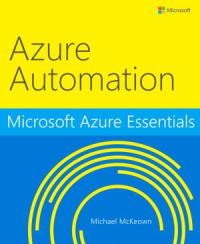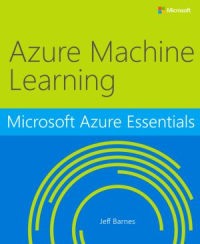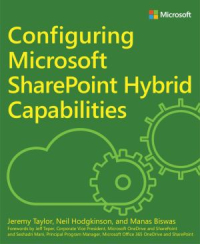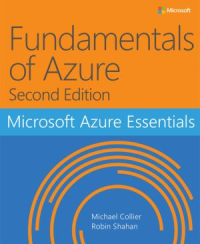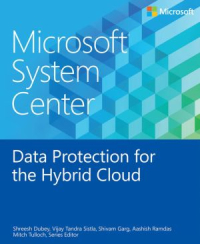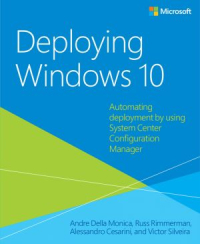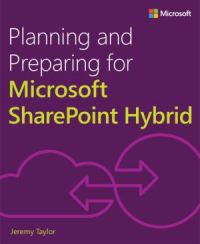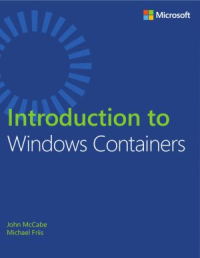Microsoft Press
Network Virtualization and Cloud Computing
As businesses move more toward cloud computing, one important factor for success is adopting multi-tenant software-defined networking (SDN) solutions in data centers. Hyper-V Network Virtualization (HNV) is a key enabler for a multi-tenant SDN solution and is essential for implementing a hybrid cloud environment where tenants can bring not only their own IPs, but their entire network topology since the virtualized networks are abstracted from the underlying fabric network. Network virtualization in general and Hyper-V Network Virtualization in particular are relatively new concepts. Unlike server virtualization, which is a mature, widely-understood technology, network virtualization still lacks this kind of broad familiarity. This brief book identifies some key usage and deployment scenarios for cloud computing to provide some deep technical background on the Microsoft SDN solution, enabling IT professionals to quickly learn the internals of HNV, how it works from end to end, and wh ...
As businesses move more toward cloud computing, one important factor for success is adopting multi-tenant software-defined networking (SDN) solutions in data centers. Hyper-V Network Virtualization (HNV) is a key enabler for a multi-tenant SDN solution and is essential for implementing a hybrid cloud environment where tenants can bring not only their own IPs, but their entire network topology since the virtualized networks are abstracted from the underlying fabric network. Network virtualization in general and Hyper-V Network Virtualization in particular are relatively new concepts. Unlike server virtualization, which is a mature, widely-understood technology, network virtualization still lacks this kind of broad familiarity. This brief book identifies some key usage and deployment scenarios for cloud computing to provide some deep technical background on the Microsoft SDN solution, enabling IT professionals to quickly learn the internals of HNV, how it works from end to end, and wh ...
Azure Web Apps for Developers
Azure Web Apps is a fully managed platform that you can use to build mission-critical web applications that are highly available, secure, and scalable to global proportions. Combined with first-class tooling from Visual Studio and the Microsoft Azure Tools, the Azure Web Apps service is the fastest way to get your web application to production. Azure Web Apps is part of the Azure App Service that is designed to empower developers to build web and mobile applications for any device. Developing web applications to host on Azure Web Apps is a familiar experience for developers accustomed to hosting web applications on Internet Information Services (IIS). Developers can use ASP.NET, Java, Node.js, PHP, and Python for their application development locally and easily deploy to Azure Web Apps. The environment supports continuous deployment to multiple staging environments, enabling development teams to deploy application updates rapidly and reliably. Azure Web Apps is more than a host f ...
Azure Web Apps is a fully managed platform that you can use to build mission-critical web applications that are highly available, secure, and scalable to global proportions. Combined with first-class tooling from Visual Studio and the Microsoft Azure Tools, the Azure Web Apps service is the fastest way to get your web application to production. Azure Web Apps is part of the Azure App Service that is designed to empower developers to build web and mobile applications for any device. Developing web applications to host on Azure Web Apps is a familiar experience for developers accustomed to hosting web applications on Internet Information Services (IIS). Developers can use ASP.NET, Java, Node.js, PHP, and Python for their application development locally and easily deploy to Azure Web Apps. The environment supports continuous deployment to multiple staging environments, enabling development teams to deploy application updates rapidly and reliably. Azure Web Apps is more than a host f ...
Operations Manager Field Experience
Part of a series of specialized guides on System Center-this book walks through the implementation of Operations Manager in the enterprise using Windows Server 2012 R2 and System Center 2012 R2, or later. Written by experts on the Microsoft System Center team and with Microsoft MVP Mitch Tulloch as series editor, this title focuses on best practices for working with management packs, maximizing the effectiveness or reporting, troubleshooting your environment, and using Operations Manager in cloud environments. ...
Part of a series of specialized guides on System Center-this book walks through the implementation of Operations Manager in the enterprise using Windows Server 2012 R2 and System Center 2012 R2, or later. Written by experts on the Microsoft System Center team and with Microsoft MVP Mitch Tulloch as series editor, this title focuses on best practices for working with management packs, maximizing the effectiveness or reporting, troubleshooting your environment, and using Operations Manager in cloud environments. ...
Azure Automation
The second ebook in the series, Microsoft Azure Essentials: Azure Automation, introduces a fairly new feature of Microsoft Azure called Azure Automation. Using a highly scalable workflow execution environment, Azure Automation allows you to orchestrate frequent deployment and life cycle management tasks using runbooks based on Windows PowerShell Workflow functionality. These runbooks are stored in and backed up by Azure. By automating runbooks, you can greatly minimize the occurrence of errors when carrying out repeated tasks and process automation. ...
The second ebook in the series, Microsoft Azure Essentials: Azure Automation, introduces a fairly new feature of Microsoft Azure called Azure Automation. Using a highly scalable workflow execution environment, Azure Automation allows you to orchestrate frequent deployment and life cycle management tasks using runbooks based on Windows PowerShell Workflow functionality. These runbooks are stored in and backed up by Azure. By automating runbooks, you can greatly minimize the occurrence of errors when carrying out repeated tasks and process automation. ...
Azure Machine Learning
This third ebook in the series introduces Microsoft Azure Machine Learning, a service that a developer can use to build predictive analytics models (using training datasets from a variety of data sources) and then easily deploy those models for consumption as cloud web services. The ebook presents an overview of modern data science theory and principles, the associated workflow, and then covers some of the more common machine learning algorithms in use today. It builds a variety of predictive analytics models using real world data, evaluates several different machine learning algorithms and modeling strategies, and then deploys the finished models as machine learning web services on Azure within a matter of minutes. The ebook also expands on a working Azure Machine Learning predictive model example to explore the types of client and server applications you can create to consume Azure Machine Learning web services. ...
This third ebook in the series introduces Microsoft Azure Machine Learning, a service that a developer can use to build predictive analytics models (using training datasets from a variety of data sources) and then easily deploy those models for consumption as cloud web services. The ebook presents an overview of modern data science theory and principles, the associated workflow, and then covers some of the more common machine learning algorithms in use today. It builds a variety of predictive analytics models using real world data, evaluates several different machine learning algorithms and modeling strategies, and then deploys the finished models as machine learning web services on Azure within a matter of minutes. The ebook also expands on a working Azure Machine Learning predictive model example to explore the types of client and server applications you can create to consume Azure Machine Learning web services. ...
Configuring Microsoft SharePoint Hybrid Capabilities
Microsoft SharePoint hybrid consists of a growing list of advanced hybrid solutions that empowers organizations to consume benefits of the cloud and maintain their on-premises investments. This book is the second in a series of SharePoint hybrid books in which we show you how to configure, troubleshoot, and manage a SharePoint hybrid environment. As you move toward configuring a SharePoint hybrid environment, you will soon realize the need for a go-to manual to ensure a successful implementation. This book does exactly that! It contains step-by-step instructions to help you with configuring and managing SharePoint hybrid. Although, it is aimed primarily for a technical audience, it also addresses business benefits that you might need to present to your management. This book covers configuring these SharePoint hybrid capabilities in detail, along with scenario-based troubleshooting and recommended practices. ...
Microsoft SharePoint hybrid consists of a growing list of advanced hybrid solutions that empowers organizations to consume benefits of the cloud and maintain their on-premises investments. This book is the second in a series of SharePoint hybrid books in which we show you how to configure, troubleshoot, and manage a SharePoint hybrid environment. As you move toward configuring a SharePoint hybrid environment, you will soon realize the need for a go-to manual to ensure a successful implementation. This book does exactly that! It contains step-by-step instructions to help you with configuring and managing SharePoint hybrid. Although, it is aimed primarily for a technical audience, it also addresses business benefits that you might need to present to your management. This book covers configuring these SharePoint hybrid capabilities in detail, along with scenario-based troubleshooting and recommended practices. ...
Fundamentals of Azure, 2nd Edition
Microsoft Azure is Microsoft's cloud computing platform, providing a wide variety of services you can use without purchasing and provisioning your own hardware. Azure enables the rapid development of solutions and provides the resources to accomplish tasks that may not be feasible in an on-premises environment. Azure's compute, storage, network, and application services allow you to focus on building great solutions without the need to worry about how the physical infrastructure is assembled. This book covers the fundamentals of Azure you need to start developing solutions right away. It concentrates on the features of the Azure platform that you are most likely to need to know rather than on every feature and service available on the platform. This book also provides several walkthroughs you can follow to learn how to create VMs and virtual networks, websites and storage accounts, and so on. In many cases, real-world tips are included to help you get the most out of your Azure expe ...
Microsoft Azure is Microsoft's cloud computing platform, providing a wide variety of services you can use without purchasing and provisioning your own hardware. Azure enables the rapid development of solutions and provides the resources to accomplish tasks that may not be feasible in an on-premises environment. Azure's compute, storage, network, and application services allow you to focus on building great solutions without the need to worry about how the physical infrastructure is assembled. This book covers the fundamentals of Azure you need to start developing solutions right away. It concentrates on the features of the Azure platform that you are most likely to need to know rather than on every feature and service available on the platform. This book also provides several walkthroughs you can follow to learn how to create VMs and virtual networks, websites and storage accounts, and so on. In many cases, real-world tips are included to help you get the most out of your Azure expe ...
Data Protection for the Hybrid Cloud
If you are responsible for architecting and designing the backup strategy for your organization, especially if you're looking for ways to incorporate cloud backup into your business continuity scenarios, this book is for you. With the increasing trends in virtualization as well as the move to the pubic cloud, IT organizations are headed toward a world where data and applications run in on-premises private clouds as well as in the public cloud. This has key implications for data protection strategy, and it is important to choose the solution that provides the same level of data protection you have afforded so far while allowing you to harness the power of the public cloud. We will cover how the Azure Backup service has evolved into a first-class platform-as-a-service (PaaS) service in Microsoft Azure that integrates with the on-premises enterprise class backup product, System Center Data Protection Manager (DPM), to provide a seamless hybrid cloud backup solution. Current backup prod ...
If you are responsible for architecting and designing the backup strategy for your organization, especially if you're looking for ways to incorporate cloud backup into your business continuity scenarios, this book is for you. With the increasing trends in virtualization as well as the move to the pubic cloud, IT organizations are headed toward a world where data and applications run in on-premises private clouds as well as in the public cloud. This has key implications for data protection strategy, and it is important to choose the solution that provides the same level of data protection you have afforded so far while allowing you to harness the power of the public cloud. We will cover how the Azure Backup service has evolved into a first-class platform-as-a-service (PaaS) service in Microsoft Azure that integrates with the on-premises enterprise class backup product, System Center Data Protection Manager (DPM), to provide a seamless hybrid cloud backup solution. Current backup prod ...
Deploying Windows 10
Get a head start deploying Windows 10 - with tips and best practices from experts in the field. This guide shows you how to deploy Windows 10 in an automated way without impacting end users by leveraging System Center Configuration Manager, which is the most used product to deploy Microsoft operating systems in the industry today. Windows 10 represents a major paradigm shift for Microsoft and the Windows ecosystem in general as we modernize the platform by introducing "as a service" capabilities. Hundreds of millions of devices are already running Windows 10 today. Businesses are beginning to evaluate the new capabilities of Windows 10, including Windows as a service, as part of their deployment plans. With Windows 7 recently transitioning into extended support, businesses need to begin planning for the future of their Windows operating system environment. Although there are many aspects to consider in managing a Windows device, one of the essential early stages of the lifecycle ...
Get a head start deploying Windows 10 - with tips and best practices from experts in the field. This guide shows you how to deploy Windows 10 in an automated way without impacting end users by leveraging System Center Configuration Manager, which is the most used product to deploy Microsoft operating systems in the industry today. Windows 10 represents a major paradigm shift for Microsoft and the Windows ecosystem in general as we modernize the platform by introducing "as a service" capabilities. Hundreds of millions of devices are already running Windows 10 today. Businesses are beginning to evaluate the new capabilities of Windows 10, including Windows as a service, as part of their deployment plans. With Windows 7 recently transitioning into extended support, businesses need to begin planning for the future of their Windows operating system environment. Although there are many aspects to consider in managing a Windows device, one of the essential early stages of the lifecycle ...
Planning and Preparing for Microsoft SharePoint Hybrid
Microsoft SharePoint hybrid deployments are rapidly becoming popular with Microsoft's investments on increased SharePoint productivity, not only in your own environment (on-premises) but also collaborating in new ways through the largest and most advanced cloud service platform in the world - Microsoft Office 365 and Microsoft Azure. SharePoint hybrid is about connecting SharePoint on-premises to Office 365 and Azure to extend capabilities, enhance collaboration, and drive innovation forward. This book is part of a series to provide readers from all over the world with a guide on how to connect SharePoint on-premises to Microsoft's cloud services. You will gain insight into planning, architecture, configuration, and management of SharePoint hybrid. This book covers foundational topics with which you will learn more about Office 365 and Microsoft Azure, architecture planning, platform hygiene and preparation, directory synchronization, and how to configure a seamless single sign-on e ...
Microsoft SharePoint hybrid deployments are rapidly becoming popular with Microsoft's investments on increased SharePoint productivity, not only in your own environment (on-premises) but also collaborating in new ways through the largest and most advanced cloud service platform in the world - Microsoft Office 365 and Microsoft Azure. SharePoint hybrid is about connecting SharePoint on-premises to Office 365 and Azure to extend capabilities, enhance collaboration, and drive innovation forward. This book is part of a series to provide readers from all over the world with a guide on how to connect SharePoint on-premises to Microsoft's cloud services. You will gain insight into planning, architecture, configuration, and management of SharePoint hybrid. This book covers foundational topics with which you will learn more about Office 365 and Microsoft Azure, architecture planning, platform hygiene and preparation, directory synchronization, and how to configure a seamless single sign-on e ...
Introduction to Windows Containers
With the introduction of container support in Windows Server 2016, we open a world of opportunities that takes traditional monolithic applications on a journey to modernize them for better agility. Containers are a stepping stone that can help IT organizations understand what key items in modern IT environments, such as DevOps, Agile, Scrum, Infrastructure as Code, Continuous Integration, and Continuous Deployment, to name just a few, can do and how these organizations can adopt all of these elements and more to their enterprises. As a result of Microsoft's strong strategic partnership with Docker - the de facto standard in container management software - enterprises can minimize the time required to onboard and run Windows Containers. Docker presents a single API surface and standardizes tooling for working across public and private container solutions as well as Linux and Windows Container deployments. This is the next phase in IT evolution in which a direct replatform of code ...
With the introduction of container support in Windows Server 2016, we open a world of opportunities that takes traditional monolithic applications on a journey to modernize them for better agility. Containers are a stepping stone that can help IT organizations understand what key items in modern IT environments, such as DevOps, Agile, Scrum, Infrastructure as Code, Continuous Integration, and Continuous Deployment, to name just a few, can do and how these organizations can adopt all of these elements and more to their enterprises. As a result of Microsoft's strong strategic partnership with Docker - the de facto standard in container management software - enterprises can minimize the time required to onboard and run Windows Containers. Docker presents a single API surface and standardizes tooling for working across public and private container solutions as well as Linux and Windows Container deployments. This is the next phase in IT evolution in which a direct replatform of code ...
